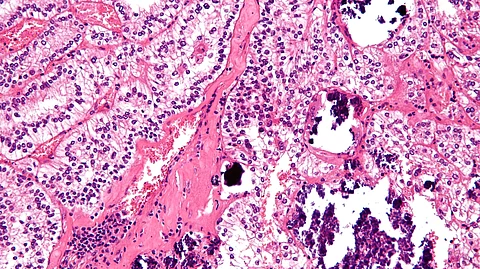How these three different oncofusions were all able to capture RNA polymerase II was unclear until the researchers compared the amino acid building blocks that make up normal or wild-type TFE3 with those that make up the three mutated oncofusion versions. They found that the mutated versions contained a higher proportion of amino acids that can chemically interact with RNA polymerase II. Upon swapping amino acids between wild-type TFE3 and the TFE3 oncofusion, the oncofusions lost their ability to interact with RNA polymerase II, whereas, conversely, wild-type TFE3 gained the ability to interact with RNA polymerase II, thus confirming the central role of the identified amino acid mixtures in capturing RNA polymerase II and in driving the process of gene transcription.
Cells carrying wild-type TFE3 engineered to carry more of the amino acids from the mutant version adopted cancerous behaviors, becoming more proliferative, invasive, and migratory. The most likely explanation is that RNA polymerase II bound by the mutant amino acids prompted the expression of genes that cause this malignant activity, said Dr. Sabari, also Assistant Professor of Molecular Biology and Obstetrics and Gynecology.
Curious about whether this mechanism might apply to other cancers, the research team combed through a database of known oncofusion mutations found in a variety of cancer types. By examining the amino acids that these mutations code for, the researchers saw combinations similar to those found in mutated TFE3 and found that these other oncofusions also captured RNA polymerase II. These findings suggest that these other oncofusions might be driving diverse cancers through a similar molecular mechanism observed for tRCC.
Finding a way to disrupt these interactions could offer a new way to treat these cancers – a topic that the Sabari Lab plans to pursue in the future.
Reference:
1. https://www.sciencedirect.com/science/article/abs/pii/S0092867425004040
(Newswise/SH)


